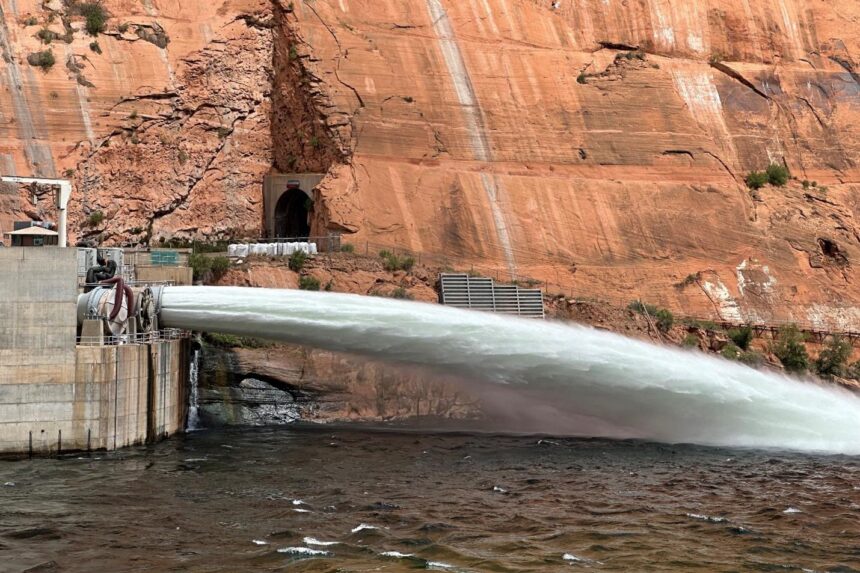Major Pipe Infrastructure Overhaul Strengthens Glen Canyon Dam’s Operational Reliability
Critically important refurbishment efforts on the pipeline systems at Glen Canyon Dam have recently concluded, representing a crucial advancement in preserving the dam’s structural and functional integrity. These comprehensive repairs and enhancements are projected to boost the dam’s safety and efficiency, ensuring robust control over water distribution and hydroelectric power production along the Colorado River. Managed by the U.S. Bureau of Reclamation, this initiative addresses the pressing need for durable infrastructure amid shifting environmental conditions and water resource demands in the southwestern United States.
Pipeline Rehabilitation Bolsters Glen Canyon Dam’s Structural Durability
The maintenance campaign at Glen Canyon Dam encompassed detailed evaluations and precise restoration of vital pipeline components. The focus was on fortifying sections susceptible to deterioration and corrosion, thereby safeguarding the dam’s capacity to regulate water pressure and flow without interruption. Utilizing cutting-edge materials and innovative sealing technologies,engineers extended the operational lifespan of these pipelines while enhancing their resistance to environmental wear and tear.
Notable improvements included:
- Substitution of compromised pipe segments with premium-grade stainless steel alloys
- Submission of advanced anti-corrosion surface treatments
- Integration of upgraded sensor arrays for real-time pipeline condition monitoring
- Reinforcement of pipe anchoring systems to mitigate stress during peak water discharge
| Pipeline Segment | Material Enhancement | Anticipated Service Life |
|---|---|---|
| Main Water Inlet | 316L Stainless Steel | Over 25 years |
| Water Release Channels | Epoxy-Coated Carbon Steel | 15+ years |
| Powerhouse Supply Lines | Composite Polymer Coating | 20+ years |
Ongoing Surveillance Identifies Critical Zones for Maintenance
Recent inspections have pinpointed several vulnerable areas within the dam’s pipeline network that require continuous monitoring and upkeep to prevent operational failures. Key concerns include joint seals showing signs of degradation, sections prone to corrosion, and pressure regulation valves needing regular calibration. These findings highlight the importance of a proactive maintenance regime to detect and address minor defects before they escalate into costly disruptions.
- Joint Seals: Reinforcement is essential to prevent leakage and maintain system integrity.
- Corrosion-Prone Areas: Ongoing treatment and surveillance are critical to mitigate metal deterioration.
- Pressure Control Valves: Routine adjustments ensure consistent water flow and system stability.
| Component | Current Status | Recommended Maintenance |
|---|---|---|
| Joint Seals | Moderate wear detected | Frequent inspections and reinforcement |
| Water Intake Pipes | Corrosion present | Protective coating application |
| Control Valves | Operational with minor adjustments needed | Scheduled recalibration |
Advanced Materials and Preventative Strategies Recommended by Experts
Industry professionals emphasize the adoption of innovative materials and forward-thinking maintenance approaches to enhance the longevity and reliability of Glen Canyon Dam’s pipeline infrastructure. The use of high-performance composites and corrosion-resistant alloys is advocated to withstand harsh environmental conditions and reduce the frequency of repairs.
Equally significant are preventative measures, including the deployment of intelligent monitoring systems and regular diagnostic inspections to identify early signs of wear or structural stress. Experts recommend:
- Implementation of smart sensor networks for continuous pipeline health assessment
- Routine ultrasonic and thermal imaging evaluations
- Utilization of AI-driven predictive maintenance models to forecast potential failures
These strategies aim to minimize unexpected outages and maintain the dam’s operational excellence well into the future.
| Material | Primary Advantage | Expected Lifespan |
|---|---|---|
| Carbon Fiber Composite | Remarkable strength-to-weight ratio | 40+ years |
| Stainless Steel Alloy | Superior corrosion resistance | 30–35 years |
| Thermoplastic Polymer | High adaptability and impact tolerance | 20–25 years |
Environmental Stewardship and Community Engagement Integral to Upgrade Process
The pipeline refurbishment at Glen Canyon Dam was executed with a strong commitment to minimizing environmental impact and fostering positive community relations. Project coordinators actively collaborated with local residents and tribal groups to incorporate their perspectives, ensuring that the work respected cultural values and community needs.Measures such as scheduling construction during less disruptive hours and maintaining open communication channels helped build trust and reduce inconvenience.
Environmental safeguards were rigorously applied to protect native ecosystems and maintain water quality. Construction protocols included:
- Utilization of environmentally friendly materials to limit chemical runoff
- Enhanced sediment control techniques to prevent contamination of the Colorado River
- Establishment of protected zones to safeguard habitats of endangered species
| Environmental Focus | Implemented Action | Result |
|---|---|---|
| Water Quality | Continuous testing and filtration systems | No violations recorded |
| Wildlife Conservation | Buffer zones around sensitive habitats | Minimal ecological disturbance |
| Community Relations | Regular town hall meetings and updates | High levels of community approval |
Conclusion: Securing Glen Canyon Dam’s Future Through Strategic Upgrades
The successful completion of the pipeline refurbishment at Glen Canyon Dam represents a pivotal step in maintaining the facility’s safety and operational efficiency.With these enhancements in place,officials anticipate improved water management capabilities and more reliable power generation. Continued vigilance through maintenance and monitoring remains a priority to ensure the dam’s critical role in regional water supply and energy production endures. Stakeholders will provide ongoing updates as the project advances into subsequent phases.
